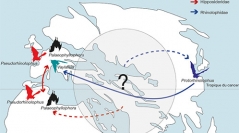

 Geodiversitas
38 (3) - Pages 355-434
Geodiversitas
38 (3) - Pages 355-434This study focuses on new fossil faunas of bats discovered in North Africa following several field campaigns. The fossiliferous localities include those from the Early to Middle Eocene of Tunisia (Chambi) and Algeria (Glib Zegdou). Systematic and cladistic analyses carried out on the fossil material, primarily including isolated teeth, allow us to highlight the modalities of the radiation of the first modern microbats. These new faunas include eight well-identified new taxa belonging to five modern families: one Necromantidae (?Necromantis fragmentum Ravel, n. sp.), two Hipposideridae Miller, 1907 (?Palaeophyllophora tunisiensis Ravel, n. sp. and Hipposideros [Pseudorhinolophus] africanum Ravel, n. sp.), three Emballonuridae Gervais in de Castelnau, 1855 (Vespertiliavus kasserinensis Ravel, n. sp., ?Vespertiliavus aenigma Ravel, n. sp., and Pseudovespertiliavus parva Ravel n. gen., n. sp.), one Nycteridae (Khoufechia gunnelli Ravel n. gen., n. sp.) and an undetermined Vespertilionidae. Two other taxa are identified (Chambinycteris pusilli Ravel n. gen., n. sp. and Drakonycteris glibzegdouensis Ravel n. gen., n. sp.), but they show an original dental pattern which precludes a family attribution. Two cladistic analyses allow to clarify the phylogenetic position of the best documented taxa. The results highlight for Hipposideridae and Emballonuridae chiropterans a major dispersal axis from North Africa towards South Europe during the Middle Eocene.
Chiroptera, radiation, Eocene, North Africa, cladistics, paleobiogeography, new genera, new species.